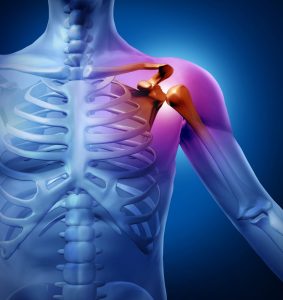
SLAP Lesions of the Shoulder
SLAP Lesions of the Shoulder

The shoulder is a ball (upper humerus or arm bone) and socket (glenoid or part of the shoulder blade) joint. The glenoid labrum is cartilage that surrounds the outer lip of the glenoid. It acts by increasing the relative depth of the glenoid to increase shoulder stability and works in a similar way to the seal on a fridge door, by sucking the ball into the socket. SLAP is an acronym for Superior Labrum Anterior to Posterior. It involves tearing or damage of the upper part of the labrum where one of the biceps tendons attaches. A SLAP lesion commonly causes pain, clicking and mild instability of the shoulder.
Causes of a SLAP lesion of the shoulder
SLAP lesions can be acute, from trauma to the shoulder or chronic, from repetitive movements of the shoulder.
Acute SLAP lesions are often caused by:
- Motor vehicle accidents
- Falls onto an outstretched arm or shoulder
- Forceful traction or pulling on the arm, eg. trying to catch a heavy object
- Shoulder dislocation or subluxation
- Forceful or rapid movement of the shoulder
Chronic SLAP lesions are often caused by repetitive overhead actions such as:
- Repetitive throwing (baseballers, cricketers, etc)
- Repetitive serving (tennis, volleyball)
- Swimming
- Weightlifting
Chronic SLAP lesions become more common with increasing age.
Signs and Symptoms of SLAP lesions
- Clicking or catching is possible
- Pain in the shoulder – usually at the top of the shoulder but can feel deep and vague
- Pain with overhead activities or lifting
- Reduction in overhead speed or power
Diagnosis of SLAP lesions
Physiotherapists are experts in the assessment and diagnosis of shoulder injuries including SLAP lesions. Sometimes shoulder injuries are difficult to isolate and further investigations such as MRI’s are required to assist with diagnosis.
Treatment of SLAP lesions
Most people with SLAP lesions achieve excellent outcomes with conservative physiotherapy treatment and rehabilitation. Treatment includes rest to allow the inflammation and pain to settle, manual therapy to reduce pain and muscular dysfunction, rehabilitation to improve muscle strength and return to sport protocols to ensure a safe and effective outcome.
Occasionally surgery may be required to repair the torn labrum if conservative treatment fails.
If you are concerned about a possible SLAP lesion or want further advice, be sure to contact the experts at our Duncraig physio clinic.